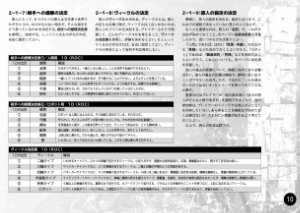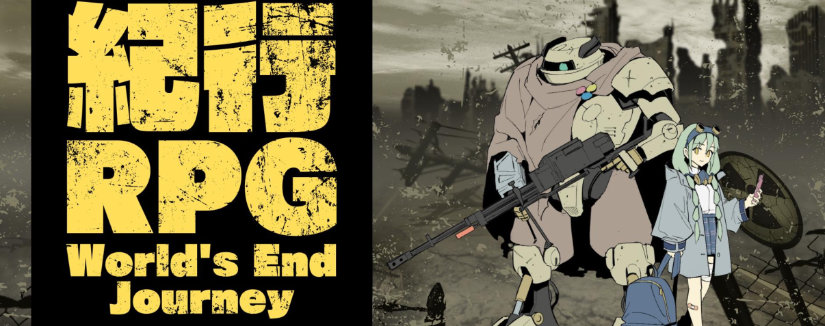World’s End Journey (終末紀行RPG) is a rules light indie TRPG about two travelers, human and robot, surviving in a world that has ended. The text from a promo image sums it up as, “No school. No society. No food. No bullets. No anything. With partner.” Using a d6 pool for resolution, it focuses on generating stories using roll or choose charts (ROC) .
 Both the free 16-page and paid 40-page PDFs are A4 landscape with a three column layout. Primarily in black and white with a few images, the sample characters are illustrated in full color. The sections are clearly labeled and handy reference numbers are provided to make navigation even easier.
Both the free 16-page and paid 40-page PDFs are A4 landscape with a three column layout. Primarily in black and white with a few images, the sample characters are illustrated in full color. The sections are clearly labeled and handy reference numbers are provided to make navigation even easier.
Setting
The setting is loosely defined with several core principals: mankind is long extinct; no other humans nor robots are around; there are no resources left, with only remnants from the past being repurposed; and the world is dangerous: in addition to the harsh landscape, mutants and drones pose a threat. The journey itself is one of survival. There’s enough guidance to set the mood, while the details are left to the GM and players to weave together. The exact year is undefined, and there both realistic (eg machine-guns) and far-future (eg laser guns) items available, but as we’ll see later, the items are about expressing the character and don’t have mechanical benefits.
Characters
There are are only two types of characters in the party: human and robot. There can only be one of each in the group, so one player plays the human and the other the robot. The difference between humans and robots comes down to their skills and goals.
To give a sense of the kinds of characters that can be expected, four example pairs are given:
- (pictured on the cover) a combat robot whose right arm has been replaced with another robot’s arm. Carries a replica machine-gun from the 21st century. The human wears a girl’s uniform from the 21st century despite it not being suited to survival.
- a cat-like humanoid guard robot with vibroclaws and a young gadgeteer frozen because they’re a genius.
- a long term survivor with combat training prior to his cryonic freeze accompanied by his trusty pet robot dog that has a love of balloons.
- a human well-trained in both combat and survival that sometimes cooks at the campfire using her shovel. With her is a near-human robot that, if not for her decorative wings and damage, could pass for human.
Attributes
There are three attributes Technology (技術), Survival (生存), and Combat (戦闘). Players place 7 points into these, with a max of 5 in one attribute. Roll or Choose (ROC) charts are used throughout this book, including stat allocation. There is a chart to determine the distribution of points and a second chart to determine attribute priority. For example, rolling a three or four on the allocation charge gives 3, 3, 1 points. Rolling a 3 on the priority chart assigns the highest to Survival (3), the next to Technology (3), and the remainder to Battle (1).
Skills
Skills are divided into common skills, robot skills, and human skills. Like attribute and most other character traits, these are defined by roll or choose charts. There are three common skills per attribute, so the ROC charts for these have two steps: determine the category and then determine the specific skill.
Common skills give a two extra dice for rolls related to the skills. For example, the Hunter skill gives plus two dice for checks related to mutants. Human and Robot speciality skills hav more variety in what they do. One of the Robot skills “Selfless Devotion” (滅私奉公) allows them to boost the human’s roll at the cost of resources. On the other hand, the “Internal Weaponry” skill gives the Robot a boost in combat.
Items
Characters are assumed to have a basic set of items for survival, so choosing an item is for character development. In particular, weapons are unrelated to the Battle attribute, with only the attribute value determining the effectiveness. In other words, a laser gun with a Battle of 1 is weaker than a bare fists with a Battle of 5.
Additional Aspects

Rounding out the characters are their goals (in addition to just surviving); their relation to their partner; and the vehicle they share.
Mechanics
World’s End Journey uses a d6 dice pool whose size is based on the appropriate Attribute. Each result of five or higher counts as a success, and each check requires a certain number of successes. This mechanic is the basis of three types of checks: solo, cooperative, and combined.
Resources
There are five Resources that are shared between the players and tracked on a scale of 0 to 3: Food and Health for the human, Electricity and Parts for the Robot, and Vehicle shared by both. These are abstract, so Power can refer to both the remaining battery charge as well as spare batteries and portable generators. Resources may be decreased by a random Resource Reduction roll or player skills that expend resources. Finding new resource can also increase the resource rating.
With the exception of Vehicle, the travelers become Exhausted (枯渇状態) when a resource reaches 0. Exhausted gives a penalty to roll results, and if Exhausted when they enter the final act, the character(s) die or cease functioning. Finally, characters also have a Motivation (動機) resource that may be spent to roll additional dice on a check.
Journey’s End
This small section really stuck with me. The game is a game of journey and survival, but surviving is not always possible. Whether a single PC or both PCs deplete their resources and fall, the game is over. Even if a character survives, they cannot be used in the game again because the game is a story of the pair, and without their partner, the story is over.
Gamemastering
It’s here that the free trial rules end and the full edition continues. The GM section covers the role of the GM, types of play, session flow, and includes a sample scenario. Of particular note is there are two types of play: random and scenario. Random play is the main form of play and is done using ROC charts in the book to dynamically generate the story. Scenario play uses a prewritten scenario.
Session Flow
Sessions are divided into advance preparation, opening part, search, closing, and cleanup. Of these, the majority of time is spent in the search part, where the characters are searching an area for resources. The area is randomly determined, with ROC tables provided for both wasteland and city areas. The search part is divided into multiple scenes, the order and type of being predefined. There are four types of scenes: obstacle, where the players may receive a reward; downtime (slice of post-apocalyptic life) where the players may receive Motivation; Extra, which is only used in prewritten scenarios; and Perilous Pass, the climax of the journey and last scene played.
The common thread to all these scene types, as well as the opening part, is the loss of resources by a Resource Reduction roll. Yes, at the very start of the game resources are already reduced. The Perilous Pass is the climatic scene that escalates multiple times, each time requiring a check to succeed and Resource Reduction roll. If all resources are one or higher at the end of this gauntlet, both characters successfully acquire resources and traverse the area, able to continue their journey. Otherwise, one or both of the PCs perish and their story is over.
Scenario
Contrary to many games, the provided scenario is not intended for new players. Instead, random play should be done before tackling it. Titled, “Beginning of the End”, it acts as a prequel where the characters begin in a shelter with resources.
A Travelogue of the World
The appendix begins by giving some additional background on the setting, but it stresses that it’s not absolute and can be modified and determined by the GM and PCs working together.
There are also optional rules for campaigns and character advancement. Character advancement is measured by finding Logs, and then using these logs to adjust attributes or skills, and collecting three allows increasing them. As an additional optional rule, using a Log to grow a character requires the player to post a travelogue publicly, such as on SNS and gives a Twitter hash tag to use.
Actual Play
If you’re interested in how the game plays, there’s an actual play (in Japanese) with the system designer SONE as the GM. Most of the icons and cards used are from the free official online tools pack.
Acquiring
The free edition contains the first sixteen pages of the core book. This covers the setting, core rules, and character making. The full rulebook continues with a GM section (20 pages) and miscellaneous additions like setting details and optional rules in an appendix (5 pages). Both are available as PDFs on Booth.
| World’s End Journey (終末紀行RPG) | |
|---|---|
| Time | 60-120 minutes |
| Players | 2-3 |
| Creators | Game Designer: SONE Character Artist: Hoimin (ほいみん) |
| Details | Official Twitter PDFs on Booth |

